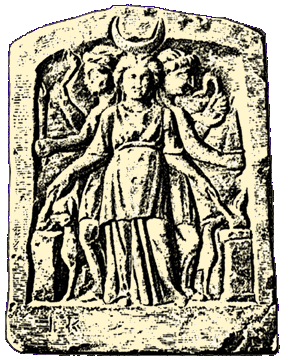|
|
The Hermetic Fellowship Website
is optimized for viewing with Netscape Navigator.
If you aren’t using Netscape, you are missing
much of the ambience of these pages (and many others on the Web)...
This page is copyright © 1995, 1996, 1998 Hermetic Fellowship.
Translation & Notes copyright © 1992, 1998 Adam P. Forrest.
Last updated at the Autumnal Equinox, 22 September, 1998 CE.
A New Annotated Translation by Adam Forrest
For Oz, Laura, and Lorain
Three of Her Daughters

Sponsored by

| Hekatê of the Path, I invoke Thee, Lovely Lady of the Triple Crossroads, | |
| Celestial, Chthonian, and Marine One, Lady of the Saffron Robe. | |
| Sepulchral One, celebrating the Bakchic Mysteries among the Souls of the Dead, | |
| Daughter of Persês, Lover of Solitude, rejoicing in deer. | |
| Nocturnal One, Lady of the Dogs, invincible Queen. | |
| She of the Cry of the Beast, Ungirt One, having an irresistible Form. | |
| Bullherder, Keeper of the Keys of All the Universe, Mistress, | |
| Guide, Bride, Nurturer of Youths, Mountain Wanderer. | |
| I pray Thee, Maiden, to be present at our hallowed rites of initiation, | |
| Always bestowing Thy graciousness upon the Boukolos. |
Hekatês
| Einodian Hekatên, klêizô, Trihoditin Erannên, | |
| Ouranian, Chthonian, te kai Einalian, Krokopeplos. | |
| Tymbidian, Psychais Nekyôn meta bakcheuosan, | |
| Perseian, Philerêmon, agallomenên elaphoisi. | |
| Nykterian, Skylakitin, amaimaketon Basileian. | |
| Thêrobromon, Azôston, aprosmachon Eidos echousan. | |
| Tauropolon, Pantos Kosmou Klêidouchon, Anassan, | |
| Hêgemonên, Nymphên, Kourotrophon, Ouresiphoitin. | |
| Lissomenos, Kourên, teletais hosiaisi pareinai, | |
| Boukolôi eumeneousan aei kecharêoti thymôi. |
Notes
| Line 1. |
Klêizô: This is an interesting verb, which can mean “to praise, to name, to call,” and “to invoke.” In the context of the Hymn, it is probably intended to convey “to invoke with praise.” |
| Line 2. |
Ouranian, Chthonian, te kai Einalian: This trio of epithets proclaims the power of Hekatê in all three divisions of the world in Greek cosmology, as represented in the threefold partition among the Three Brothers --- Zeus, Hades, and Poseidon. |
| Line 3. |
Bakcheuosan: This verb is sometimes used to mean simply “to revel,” but in the context of the Orphic Mystery cults, which have the Mysteries of Dionysos at their very core, the literal translation which I have employed is almost certainly the correct one. |
| Line 4. |
Perseian: Perseia |
| Line 4 bis. |
Agallomenên elaphoisi: “Rejoicing in deer”. A characteristic perhaps borrowed from Artemis. |
| Line 5. |
Nykterian: As Hekatê was called Nykteria, “She of the Night,” Dionysos was known as Nykterios. |
| Line 6. |
Thêrobromon: The meaning of this epithet is debatable. It may mean “She of the Cry of the Beast,” “She Who Roars Like a Beast,” “She Who Causes the Beasts to Roar,” etc. The second part of the epithet is one of Dionysos’ most well-known allonyms (Bromos or Bromios), “the Roarer,” which may (in His case, as contended by A.B. Cook) have originally referred to the roar of thunder, as Dionysos Zagreus is the Heir of Zeus. |
| Line 7. |
Tauropolon: “Bullherder” is a title She shares with Artemis. |
| Line 7 bis |
Pantos Kosmou Klêidouchon: Klêidouchos |
| Line 8. |
Hêgemonên: This title, “Guide,” is identical with that of one of the Greater Officers in the Order of the Golden Dawn in the Outer. |
| Line 8 bis |
Nymphên: May mean either “Bride” or “Nymph.” |
| Line 8 ter |
Kourotrophon: “Nurturer of Youths” is a title She shares with Artemis. In regard to this archetypal rôle of the Dark Goddess, it may be worth noting that in the Celtic Tradition preserved in the mediæval romances, it is the Nine Witches of Cær Loyw who teach Peredur, the Grail Hero, much of his heroic skill. And in Ireland, the Queen of Tir Scaith (“the Land of Shadows”) instructs the hero Cuchullain. |
| Line 9. |
Kourên: “Maiden; Daughter.” This may possibly be intended as an identification with Persephonê, the Korê. |
| Line 10. |
Boukolôi: It was decided to leave Boukolos (“Oxherd”) untranslated as a technical term, as we know from surviving inscriptions that Boukolos is the name of a high office in Orphic societies. Orphics may have called their group leaders Oxherds on the same analogy as that by which some Christians came to call theirs Shepherds (Latin, Pastores). |
If you have enjoyed this site, don’t forget to bookmark it
in your browser or add it to the Links at your website.
|
|
 |
Return to the HF Ancient Mysteries Page |
 |
Return to the Hermetic Fellowship Home Page |
![]()